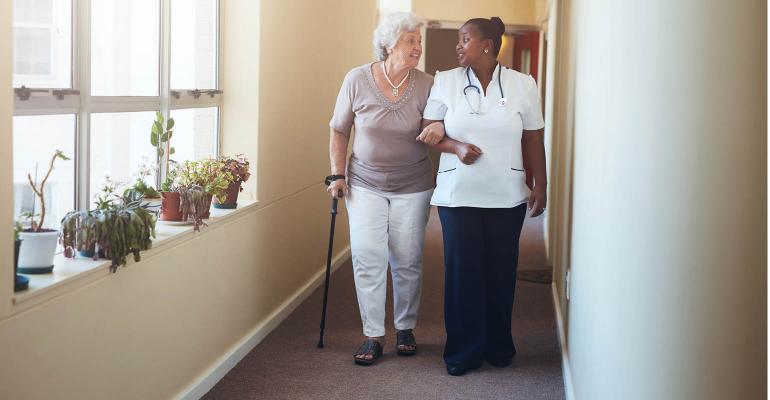Investors, especially private equity players, see increasing value in a nursing home portfolios, according to the National Investment Center for Seniors Housing & Care (NIC) research.
Nursing homes are increasingly becoming a target for commercial real estate investors, especially if they can achieve economies of scale, according to Zach Bowyer, senior managing director at real estate services firm CBRE. According to a summer 2019 CBRE U.S. Seniors Housing & Care survey, investor interest increased in the nursing care sector.
“The sector is still extremely fragmented, with the 10 largest nursing care operators comprising only 14 percent of total supply,” says Bowyer. “We see considerable opportunity in this sector, but only under a very advanced lens.”
Around 32 percent of U.S. nursing homes is operated by single-property owners. An additional 31 percent is operated by a chain with two to nine properties, according to NIC data.
Acquisition volume by private equity buyers in the nursing care space reached $3.07 billion in 2018, an increase from $417 million in 2009, according to data from research firm Real Capital Analytics (RCA).
“We are seeing more and more capital chasing the space. Yields continue to be very attractive,” says Ben Firestone, senior managing director at Blueprint, an advisory firm focused on seniors housing and healthcare real estate. “The private equity market continues to roar like I’ve never seen it in my career.”
The rate of investment sales transactions involving U.S. nursing homes has been steadily rising year-over-year since 2014, according to data from Reonomy, a commercial real estate data and analytics company based in New York City. In 2018, 3.3 percent of the existing nursing home stock sold, compared to 3.2 percent in 2017. In 2016, 3.1 percent of the existing nursing home stock changed hands, compared to 2.90 percent in 2015. In 2014, 2.30 percent of existing nursing home stock sold.
That’s 970 nursing homes sold in 2018, compared to 685 nursing home sold in 2014, according to Reonomy data.
But different data sets show different stories. While sales volume increased from 2014 to 2018, NIC data does not show the steady upward trajectory year-over-year like Reonomy research. Still, sales volume reached around $5.568 billion at the end of 2018, compared to around $4.830 billion in 2014, NIC found.
State regulations place a major constraint on the development of new nursing homes, as developers cannot build new properties from scratch without state permission. Legislators require a certificate of need (CON) in order to greenlight the development. The state also manages licensures (CON process), so requirements can differ from state to state. Traditionally, most states have maintained a moratorium on CONs. Very recently, states have started to lift these moratoriums and, in some cases, are removing their CON requirements altogether. This is what is allowing new nursing home development to proceed.
“You’re not seeing an increased amount of nursing homes, you’re actually seeing a marginal decrease,” says Firestone. “I’m not seeing an increase in the number of skilled nursing facilities. If there are new facilities, we’re seeing those replace older facilities that have become functionally obsolete.”
But industry experts, including Firestone, see increasing investor appetite in the nursing care space.
“I think there are certainly buyers for [nursing homes]. We’ve heard a lot about the challenges with the skilled nursing sector over the last few years,” says Bill Kauffman, senior principal with NIC. “That said, there have been properties that have been sold… Now, we have seen over the last couple of years, we’ve seen the price per bed, which is one of the measurements when you’re talking about the actual price of these properties, price-per-bed did decrease. So, the market was adjusting, according to our data, but you did have buyers, depends on the pricing point."
Nursing care construction starts are also at the lowest levels since NIC began tracking the data.
“After pressure on occupancy for many years, skilled nursing supply and demand could be at an inflection point as supply growth has been limited, given CONs,” says Kauffman. “Now, if demand is picking up, we can be at an inflection point where you’re going to see upward pressure on occupancy.”
Along with private equity players allocating more capital to the space, public and institutional funds are also increasing investments in the nursing care sector.
Acquisitions by public buyers reached around $2.1 billion in 2018, an uptick from $206 million in 2008. Acquisitions by institutional investors reached around $99.6 million, up from around $37.8 million in 2008.
Thirty-nine states saw an increase in the number of nursing home sales from 2014 to 2019, according to Reonomy data. Further, a number of these transactions involving nursing homes are in Opportunity Zones. Around 12.37 percent of nursing homes in the U.S. can qualify as Opportunity Zone investments, according to Reonomy.
For this reason, opportunity zone legislation “may exacerbate sales even further” in the nursing home sector, according to Sam Viskovich, vice president of marketing at Reonomy.


No comments:
Post a Comment